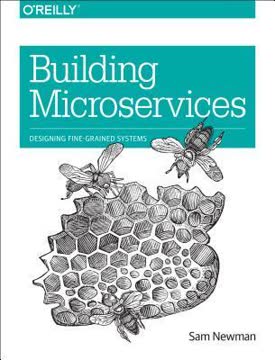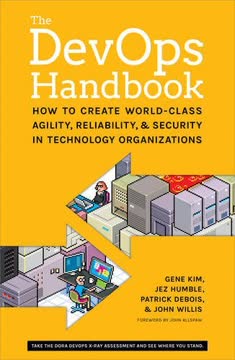Key Takeaways
1. Software delivery performance drives organizational success
High performers were twice as likely to exceed these goals as low performers.
Competitive advantage. In today's digital landscape, software delivery capability provides a significant competitive edge. High-performing organizations in software delivery consistently outperform their peers across various metrics:
- Profitability
- Productivity
- Market share
- Customer satisfaction
- Operating efficiency
- Achievement of organizational goals
Measurable impact. The research shows that high performers in software delivery are twice as likely to exceed both commercial and non-commercial performance goals compared to low performers. This demonstrates the critical role of effective software delivery in driving overall organizational success across industries and sectors.
2. Measure and improve key metrics for high performance
We settled on four: delivery lead time, deployment frequency, time to restore service, and change fail rate.
Key performance indicators. To assess and improve software delivery performance, organizations should focus on four critical metrics:
- Delivery lead time: Time from code commit to production
- Deployment frequency: How often deployments occur
- Time to restore service: How quickly issues are resolved
- Change fail rate: Percentage of changes causing failures
Continuous improvement. High performers excel across all four metrics, demonstrating that there are no trade-offs between speed and stability. By tracking and optimizing these metrics, organizations can identify bottlenecks, streamline processes, and drive continuous improvement in their software delivery capabilities.
3. Cultivate a generative organizational culture
Westrum's description of a rule-oriented culture is perhaps best thought of as one where following the rules is considered more important than achieving the mission.
Culture types. Organizational culture plays a crucial role in software delivery performance. Westrum's typology identifies three cultural types:
- Pathological (power-oriented)
- Bureaucratic (rule-oriented)
- Generative (performance-oriented)
Fostering generative culture. A generative culture, characterized by high cooperation, shared risks, bridging between teams, and a focus on inquiry and learning from failures, is strongly correlated with high performance. To cultivate this culture:
- Encourage open communication and information sharing
- Prioritize mission and performance over rigid rule-following
- Create a blame-free environment that views failures as learning opportunities
- Promote cross-functional collaboration and breaking down silos
4. Implement continuous delivery practices
Continuous delivery is a set of capabilities that enable us to get changes of all kinds—features, configuration changes, bug fixes, experiments—into production or into the hands of users safely, quickly, and sustainably.
Key practices. Implementing continuous delivery (CD) is crucial for high performance. Core CD practices include:
- Version control for all production artifacts
- Automated deployment processes
- Continuous integration
- Trunk-based development
- Comprehensive test automation
- Proactive monitoring and observability
Benefits of CD. Continuous delivery practices contribute to:
- Faster time-to-market for new features
- Improved software quality and stability
- Reduced deployment pain and team burnout
- Increased employee satisfaction and productivity
5. Design loosely coupled architecture for scalability
Having a loosely coupled architecture allows your teams to work independently, without relying on other teams for support and services, which in turn enables them to work quickly and deliver value to the organization.
Architectural principles. A loosely coupled, well-encapsulated architecture enables teams to:
- Test and deploy independently
- Make changes without extensive coordination
- Scale development efforts as the organization grows
Conway's Law in reverse. Organizations should evolve their team structures to match the desired architecture, known as the "inverse Conway Maneuver." This approach:
- Reduces communication overhead
- Increases team autonomy and productivity
- Enables faster, more frequent deployments
6. Adopt Lean management principles
The use of work-in-process limits to manage the flow of work is well known in the Lean community. When used effectively, this drives process improvement, increases throughput, and makes constraints visible in the system.
Lean practices. Key Lean management principles for software delivery include:
- Limiting work in progress (WIP)
- Visualizing work and key metrics
- Using data to inform decision-making
- Implementing lightweight change approval processes
Impact on performance. Adopting these Lean practices leads to:
- Improved software delivery performance
- Enhanced organizational culture
- Reduced burnout and increased job satisfaction
- Better alignment between work and organizational goals
7. Practice transformational leadership
Being a leader doesn't mean you have people reporting to you on an organizational chart—leadership is about inspiring and motivating those around you.
Leadership dimensions. Transformational leadership comprises five key characteristics:
- Vision
- Inspirational communication
- Intellectual stimulation
- Supportive leadership
- Personal recognition
Empowering teams. Transformational leaders:
- Provide clear direction and purpose
- Encourage innovation and creative problem-solving
- Support and develop team members
- Recognize and celebrate achievements
- Foster a culture of continuous learning and improvement
8. Prioritize employee satisfaction and diversity
Teams with more diversity with regard to gender or underrepresented minorities are smarter, achieve better team performance, and achieve better business outcomes.
Satisfaction drivers. Key factors contributing to employee satisfaction in tech roles include:
- Meaningful work with appropriate challenges
- Autonomy in tool selection and decision-making
- Opportunities for learning and growth
- Supportive team environment
Diversity benefits. Diverse teams outperform homogeneous ones. To improve diversity:
- Actively recruit and retain women and underrepresented minorities
- Create an inclusive culture that values diverse perspectives
- Address unconscious biases in hiring and promotion processes
- Provide mentorship and support for underrepresented groups
9. Integrate security throughout the development lifecycle
Our research shows that building security into software development not only improves delivery performance but also improves security quality.
Shift-left security. Integrating security early and throughout the development process:
- Reduces time spent remediating security issues
- Improves overall software quality
- Enhances delivery performance
Key practices. To effectively integrate security:
- Conduct security reviews for major features
- Include security experts in the design and demo process
- Provide pre-approved, easy-to-use security libraries and tools
- Automate security testing as part of the CI/CD pipeline
10. Embrace experimentation and learning
Our goal should be to discover how we could improve information flow so that people have better or more timely information, or to find better tools to help prevent catastrophic failures following apparently mundane operations.
Continuous learning. Foster a culture of experimentation and learning by:
- Encouraging teams to try new ideas and technologies
- Allocating time for exploration and innovation (e.g., 20% time)
- Conducting regular retrospectives and sharing lessons learned
- Celebrating both successes and failures as learning opportunities
Data-driven improvement. Use data and feedback to:
- Identify areas for improvement in processes and practices
- Make informed decisions about technology investments
- Continuously adapt and evolve your approach to software delivery
By embracing these key takeaways and implementing the associated practices, organizations can significantly improve their software delivery performance, driving better business outcomes and maintaining a competitive edge in the digital age.
Last updated:
FAQ
What's "Accelerate: Building and Scaling High Performing Technology Organizations" about?
- Focus on DevOps and Performance: The book explores how DevOps practices can improve software delivery performance and, in turn, organizational performance.
- Research-Based Insights: It is based on rigorous research, including surveys and data analysis, to identify key capabilities that drive high performance in technology organizations.
- Continuous Improvement: The authors emphasize the importance of continuous improvement and learning within organizations to remain competitive.
- Cultural and Technical Practices: It covers both cultural and technical practices that contribute to high-performing teams and organizations.
Why should I read "Accelerate: Building and Scaling High Performing Technology Organizations"?
- Evidence-Based Practices: The book provides evidence-based practices that have been proven to improve software delivery and organizational performance.
- Comprehensive Framework: It offers a comprehensive framework for understanding and implementing DevOps and Lean management practices.
- Actionable Insights: Readers will gain actionable insights into how to transform their organizations into high-performing technology teams.
- Broad Applicability: The principles and practices discussed are applicable to organizations of all sizes and industries.
What are the key takeaways of "Accelerate: Building and Scaling High Performing Technology Organizations"?
- Importance of Software Delivery Performance: High software delivery performance is critical for organizational success and can be a competitive advantage.
- Role of Culture: A generative, performance-oriented culture is essential for high performance and can be influenced by implementing DevOps practices.
- Continuous Delivery Practices: Implementing continuous delivery practices leads to better software delivery performance and reduces deployment pain and burnout.
- Leadership and Management: Transformational leadership and Lean management practices are crucial for supporting high-performing teams.
What are the best quotes from "Accelerate" and what do they mean?
- "You can act your way to a better culture by implementing these practices in technology organizations." This quote emphasizes that culture change can be achieved through deliberate actions and practices.
- "High performers understand that they don’t have to trade speed for stability or vice versa." It highlights that with the right practices, organizations can achieve both speed and stability in software delivery.
- "The goal of a loosely coupled architecture is to ensure that the available communication bandwidth isn’t overwhelmed by fine-grained decision-making." This underscores the importance of designing systems that allow teams to work independently and efficiently.
How does "Accelerate" define and measure software delivery performance?
- Four Key Metrics: The book defines software delivery performance using four key metrics: lead time, deployment frequency, time to restore service, and change fail rate.
- Cluster Analysis: It uses cluster analysis to categorize organizations into high, medium, and low performers based on these metrics.
- No Trade-Offs: The research shows that high performers excel in both speed and stability, debunking the myth that these are trade-offs.
- Impact on Organizational Performance: High software delivery performance is linked to better organizational outcomes, such as profitability and market share.
What role does culture play in "Accelerate"?
- Westrum's Typology: The book uses Westrum's typology to model organizational culture, focusing on information flow and trust.
- Generative Culture: A generative, performance-oriented culture is linked to better software delivery and organizational performance.
- Influencing Culture: Culture can be influenced by implementing DevOps practices, which improve collaboration and information flow.
- Measuring Culture: The book provides a framework for measuring culture using Likert-type questions to assess team dynamics.
What are the continuous delivery practices discussed in "Accelerate"?
- Key Principles: Continuous delivery involves building quality in, working in small batches, and automating repetitive tasks.
- Technical Practices: It includes version control, deployment automation, continuous integration, and test automation.
- Impact on Performance: These practices lead to faster, more reliable software releases and reduce deployment pain and burnout.
- Cultural Influence: Implementing continuous delivery practices positively impacts organizational culture and employee satisfaction.
How does "Accelerate" address leadership and management?
- Transformational Leadership: The book emphasizes the importance of transformational leadership in driving high performance.
- Five Dimensions: Transformational leaders exhibit vision, inspirational communication, intellectual stimulation, supportive leadership, and personal recognition.
- Role of Managers: Managers play a critical role in connecting strategic objectives to team actions and creating a supportive work environment.
- Leadership's Indirect Impact: Leadership indirectly influences performance by enabling technical and Lean practices.
What is the significance of Lean management in "Accelerate"?
- Lean Practices: Lean management practices include limiting work in progress, visualizing work, and using monitoring tools for decision-making.
- Impact on Culture: These practices contribute to a generative culture and reduce burnout.
- Lightweight Change Management: The book advocates for a lightweight change approval process based on peer review rather than external boards.
- Continuous Improvement: Lean management supports continuous improvement and aligns team efforts with organizational goals.
How does "Accelerate" suggest organizations handle information security?
- Shift Left on Security: The book recommends integrating security into the software delivery process rather than treating it as a separate phase.
- Infosec Involvement: Information security teams should be involved throughout the development lifecycle, providing feedback and tools.
- Reducing Security Remediation: High performers spend less time on security remediation by building security into their processes.
- Rugged DevOps: The book introduces the concept of Rugged DevOps, emphasizing the importance of security in DevOps practices.
What does "Accelerate" say about employee satisfaction and engagement?
- Employee Net Promoter Score (eNPS): High-performing organizations have better employee loyalty, as measured by eNPS.
- Identity and Values Alignment: Employees who identify with their organization's values are more engaged and satisfied.
- Impact on Performance: Employee satisfaction and engagement are linked to better organizational performance and reduced burnout.
- Tools and Resources: Providing employees with the right tools and resources is crucial for job satisfaction and performance.
How does "Accelerate" address diversity and inclusion?
- Importance of Diversity: The book highlights research showing that diverse teams achieve better performance and business outcomes.
- Current State: It provides statistics on the representation of women and minorities in DevOps teams.
- Inclusion: Diversity alone is not enough; organizations must also foster an inclusive environment where all members feel valued.
- Resources for Improvement: The book suggests resources like Anita Borg Institute and Project Include to support diversity initiatives.
Review Summary
Accelerate receives mixed reviews, with ratings ranging from 1 to 5 stars. Positive reviews praise its research-backed insights on DevOps practices and organizational performance. Critics find it repetitive, dull, and lacking in new information. Many readers appreciate the book's scientific approach but find the writing style dry and academic. Some consider it essential reading for tech leaders, while others feel it's best suited for those new to DevOps concepts. The book's structure and content organization are points of contention among reviewers.
Similar Books










Download PDF
Download EPUB
.epub digital book format is ideal for reading ebooks on phones, tablets, and e-readers.




